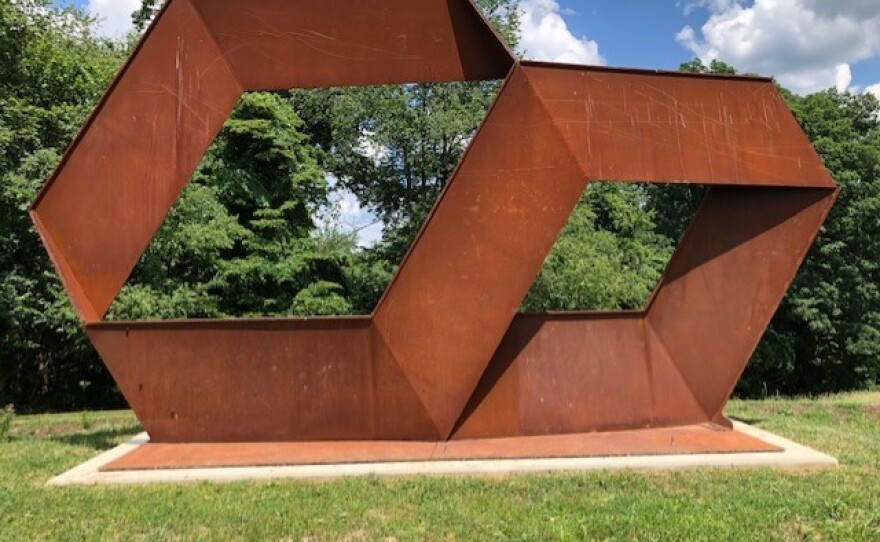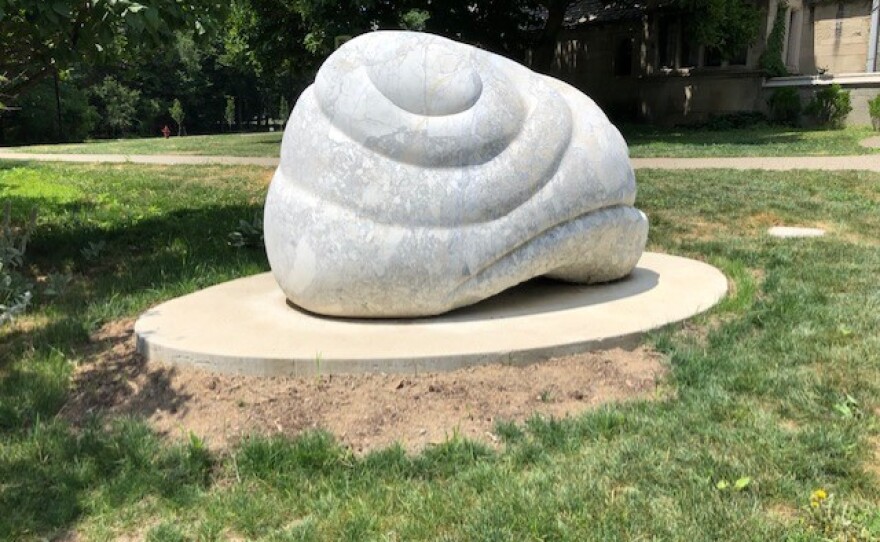For decades, visitors to Hartwood Acres have puzzled over the park’s more than one dozen large-scale sculptures – and not just because they’re all abstract works.
The pieces, most made of steel, sat scattered throughout the park. Most of them were positioned along hiking trails, without any signage indicating their titles or even the names of the artists who created them. And after a couple generations out in the elements, many were beginning to show their age.

“Nobody knew what they were or why they were here,” said Caren Glotfelty, executive director of the Allegheny County Parks Foundation.
About six years ago, the foundation decided to do something about it. And on Sunday, the foundation and county officials unveiled the fruits of their labor: the Sculpture Garden at Hartwood Acres, the Pittsburgh region’s biggest public sculpture garden.
The $3.9 million project restored all the artworks, including several whose colorful paintjobs had weathered away. It added signage with titles and artist credits. And perhaps most importantly for visitors, it gathered 11 sculptures – including a new commission by Wilkinsburg-based Dee Briggs – along a new landscaped, accessible path encircling the landmark Hartwood Acres Mansion. Two other restored sculptures sit at the park’s Saxonburg Boulevard entrance, and a third, David Hayes’ primary-colored “Large Escargot,” sits on the grounds of Hartwood Acres’ popular amphitheater.
The sculptures roughly ringing the mansion form the project’s core. “We thought by connecting them with walkways, putting in landscaping, it would make a really beautiful destination for people who wanted to have a picnic, or just walk,” said Glotfelty. She added that nationally, sculpture gardens like upstate New York's Storm King Art Center have proved popular tourist destinations, especially during the pandemic.
Hartwood Acres is located in Hampton and Indian townships. Sunday’s ribbon-cutting included remarks by County Executive Rich Fitzgerald, Allegheny County Parks Foundation board president Chip Babst, and Dusty Elias Kirk, board chair of the Allegheny Regional Asset District, whose $1 million grant served as seed money for the project. Other guests included former Pennsylvania Gov. Tom Corbett and his wife, Susan Corbett, who live in the area and frequent the park.
According to materials provided by the county, most of the sculptures were created in the 1970s and early 1980s. The majority are in a style popular at the time—sculpture restoration coordinator Morton Brown calls it “minimalist abstract … monumental sculpture”—and many are by renowned artists. They include works like “Stretch,” a pair of conjoined rectangular steel forms by Charles Ginnever; Jack Youngerman’s “Totem: Lamina: Lumbus,” its three freestanding, leaflike components individually painted red, white, or blue; and Tillie Speyer’s “Large Snail,” the collection’s lone work in marble.
All the sculptures save Briggs’ “Margie and Pete” (commissioned in 2021) originally had other homes before the park acquired or borrowed them. Joseph Goto’s “Tower Iron, Sculpture No. 5,” reminiscent of a machine, is on long-term loan from the Carnegie Museum of Art and formerly sat outside the WQED studios, in Oakland. David von Schlegell’s “North Light,” a 25-foot-tall work in painted aluminum that resembles a piece of paper curling at one edge, formerly lived outside Downtown’s One Oxford Centre.
“It’s an amazing collection, so I’m just delighted to have been included in this collection,” said Briggs. Her assertive sculptures are exhibited in cities across the U.S., but “Margie and Pete” is her first permanent public work in Southwestern Pennsylvania, where she grew up. The sculpture consists of two 25-foot-long sheets of weathering steel, each folded vertically to a right angle, and positioned closely together. She said the work is titled for her late, beloved great-uncle and great-aunt, because once erected on site it reminded her of them dancing.
Restoration of the older artworks was by McKay Lodge Laboratory Fine Art Conservation of Oberlin, Ohio, and LINEAGE Historic Preservation Services, of Sewickley.
The design team for the garden was led by La Quatra Bonci Associates, whose new landscaping around the iconic mansion includes nearly 300 trees, more than 100 shrubs, and thousands of perennials. Most of the plants are native to the region. There are also rain gardens. Two nearby parking lots have also been renovated.
















